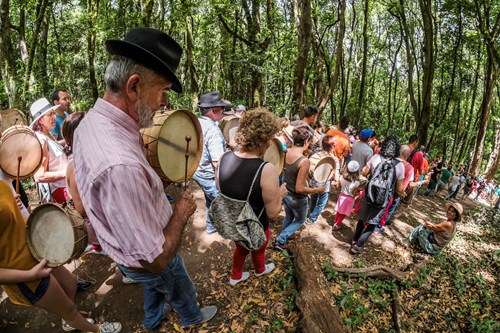“Baile del Tambor” is one of the cultural emblems of La Gomera. This dance has been present in the most important moments of life of many generations of gum trees. Today, it is still very popular at parties and pilgrimages.
It is a unique folkloric manifestation in the Hispanic world, a song and dance ancestral, in which the singing of ballads with dance warring, own music and choreography canary are combined.
The ballads or “romances” are narrative poems that tell a complete story in verse, with the protagonists historical events and of course the events of the island of La Gomera, their fortunes and misfortunes.
Such romances, came to Canary Islands with the conquerors in the fifteenth century, when the ballads lived in the Iberian Peninsula its period of maximum splendor, surviving in La Gomera until today thanks to the roots of this cultural manifestation. The prestigious professor of Spanish Philology at the University of Las Palmas, Maximiliano Trapero, La Gomera considers as the most important of the Hispanic world on conserving the traditional ballad that serves letter to the drumbeat place.

“Baile del Tambor” is a mixed dancing, having a row of warring couples. This agitated dance, performed to the rhythm of drums and chácaras, these are hollow percussion instruments generally moral wood that are tied to each hand and produce a peculiar sound.
The most characteristic dancing drum element is the “moving” which are the various steps or forms of dance, that from a few basic steps, allow each person to freely express what they feel, helping the “Baile del Tambor” be a changing and dynamic dance. The rhythmic monotony, thus inventing the mature dancers moving or steps. Exist today, “moving” to retain the name of the person who created them and even formerly the village from which the dancer could be recognized by the changes he played.
To start the “Drum Dance” (“Baile del Tambor”) both surefooted as a procession must be a sufficient number of drums, responders (chorus) and to a lesser extent, chácaras. A “romanciaor” (solo) intones a foot or leg romance (Chorus) improvised in the moment and repeated two or three times until you learn the rest. Once the “respondeores” (chorus) well answer your foot begins romance. It is then, when they start to sound chácaras and will also incorporate the “dancers” progressively.
The more daring vanity chácaras dancer brings a woman and the rest, or does the same, or observe the different “moving” (steps) of women dancing and expect to relieve the partner. This relay is putting a chacara up to his ear and another to the waist of dancing yelling !, I’m going! Jii! … The first “dancer” should leave and give way. Otherwise it will be understood as a contempt. The woman can never be relieved. When he retires, he is to leave. During the dance, she will sacándole different “moving” the man, who has to imitate.
The “romanciaores” take turns according to the extension of romance or fatigue. To indicate that changes from “romanciaor” which is singing repeats the foot or leg of romance. The dance will last until the romance is over.
The origin of the “Baile del Tambor” is uncertain, some authors assume that it is a pastoral dance brought from pointing out obvious parallels with dancing tambourine Asturian vaqueiros Peninsula, others are like the musical manifestations of certain tribes of North Africa … the truth is that is a wonderful form of expression of spirituality and emotions of the gomera society, a society that is proud of its origins and all its symbols of identity.
